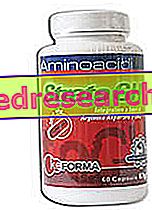Econazole is an azole antifungal effective against fungal skin and vaginal infections. It is, in fact, available in the form of pharmaceutical formulations suitable for cutaneous and vaginal use.

Econazole - Chemical Structure
Indications
For what it uses
Econazole for cutaneous use is used in the treatment of:
- Mycosis caused by dermatophytes;
- Mycoses caused by yeasts or molds;
- Infections sustained by Gram-positive bacteria;
- Mycosis of the ear canal (only when econazole is in the form of a skin emulsion);
- Mycosis of nails;
- Pityriasis versicolor.
Instead, econazole for vaginal use is used in the treatment of:
- Vulvovaginal fungal infections.
Warnings
If hypersensitivity reactions or irritations occur during econazole therapy, treatment with the drug should be stopped immediately.
The use of econazole for vaginal use may decrease the effectiveness of latex-containing contraceptives.
Econazole should only be used externally, should not be swallowed and should not be used ophthalmic.
Interactions
Econazole for both cutaneous and vaginal use, may interfere with the activity of oral anticoagulant drugs. In fact, patients already on therapy with these types of drugs that must also undergo treatment with econazole must undergo controls of the coagulation parameters more frequently than usual.
In any case, it is always good to inform your doctor if you are taking - or if you have recently been - drugs of any kind, including non-prescription medicines and herbal and / or homeopathic products.
Side effects
Econazole can cause various side effects, although not all patients experience them. This depends on the sensitivity that each individual has towards the drug. Therefore, it is not said that all adverse effects occur with the same intensity in each patient.
The main side effects that may occur during econazole therapy are listed below.
Skin and subcutaneous tissue disorders
Treatment with econazole, both for cutaneous use and for vaginal use, can cause:
- Hypersensitivity reactions;
- Angioedema;
- Rash;
- Urticaria;
- Itch;
- Burning or pain of the skin.
Furthermore, econazole for cutaneous use can cause contact dermatitis, exfoliation of the skin and can favor the formation of vesicles.
The use of econazole for vaginal use, on the other hand, can cause burning, stinging pain, itching or favoring the appearance of erythemas at the application site, therefore in correspondence to the genital areas.
Other side effects
The econazole-based therapy can also favor the onset of feelings of discomfort, feelings of discomfort and swelling.
Overdose
No cases of topical overdose of econazole are known.
If econazole is accidentally ingested (both for skin use and for vaginal use), symptoms such as nausea, vomiting and diarrhea may occur.
In case of accidental drug ingestion it is necessary to contact the doctor immediately and contact the nearest hospital.
Action mechanism
As mentioned above, econazole is an azole-type antifungal and exerts its fungicidal function by interfering with the synthesis of ergosterol.
Ergosterol is a sterol and is one of the constituents of the plasma membrane of fungal cells.
More in detail, econazole - like all azole antifungal agents - is capable of inhibiting one of the key enzymes in the synthesis of the aforementioned ergosterol, 14α-demethylase.
By inhibiting this enzyme there is an accumulation of ergosterol precursors inside the fungal cell.
The ergosterol precursors, when they reach too high levels in the cell, become toxic for the cell itself and, moreover, cause alterations of the permeability of the cell membrane and alterations in the functioning of the proteins contained in it.
The fungal cell is thus condemned to certain death.
Mode of Use - Posology
Econazole for dermal use is available as a cream, spray, powder, emulsion and skin solution.
Instead, econazole for vaginal use is available in the form of cream, ovules and vaginal solution.
During therapy with econazole it is essential to follow the instructions provided by the doctor, both as regards the amount of drug to be used and the duration of the therapy itself.
Below are some indications on the doses of econazole usually used in therapy.
Treatment of mycoses and skin infections
For the treatment of fungal infections and skin infections, it is recommended to apply cutaneous econazole twice a day - in the morning and in the evening - for a period of 1-3 weeks. The treatment should then continue for a few days after the symptoms have disappeared.
In any case, if the doctor considers it necessary, he can decide to vary the amount of econazole to be administered and the duration of the treatment.
Treatment of vaginal mycoses
For the treatment of vaginal mycoses, it is generally recommended to apply econazole vaginally once a day - before bedtime - for a period of at least two weeks.
When eggs are used, the dosage remains the same, that is, it is advisable to use an egg in the evening before going to bed for a period of two weeks.
Also in this case - if deemed necessary - the doctor may decide to vary the dose and duration of the treatment.
Pregnancy and breastfeeding
Econazole, whether for oral use or for vaginal use, should not be used in the first trimester of pregnancy, unless the doctor considers it absolutely essential. In the second and third trimesters, on the other hand, the drug can only be used if the potential benefits expected for the mother outweigh the potential risks to the fetus.
Econazole should be used with extreme caution in breastfeeding mothers, since it is not known whether the drug is excreted in breast milk.
Contraindications
The use of econazole is contraindicated in patients with known hypersensitivity to econazole itself.



